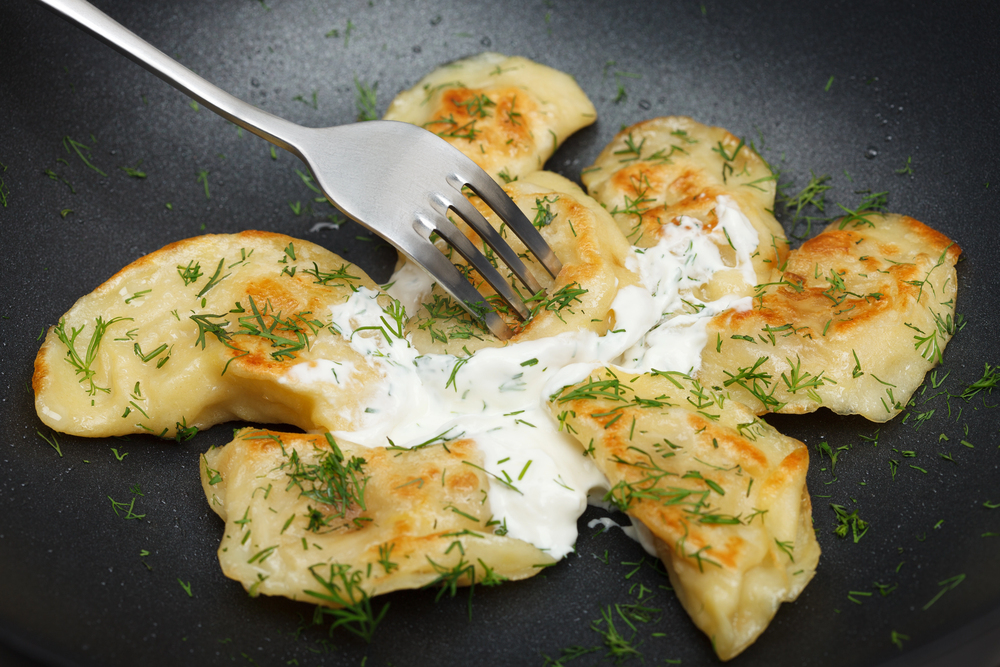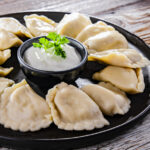Pierogies, those delightful half-moon shaped dumplings, have deep roots in Eastern Europe. They have earned fans worldwide. While classic fillings like potato and cheese are always popular, spinach and feta offer a fresh, exciting taste. This post explores spinach pierogies. We’ll examine their history, the health benefits of spinach, how to make pierogi dough, and share authentic recipes. For those who prefer convenience, frozen pierogies are a great alternative, with many brands offering vegan varieties.
A Culinary Journey Through Time: The Origins of Pierogies
The history of pierogies is intriguing, with several theories about their origins. Their exact birthplace isn’t known. One theory suggests pierogies are related to Chinese dumplings, possibly brought to Eastern Europe via the Silk Road. A charming legend says that Saint Hyacinth, a 13th-century Polish saint, introduced pierogies to Poland after visiting Kyiv. Many countries have their own versions of these dumplings. Poland and Slovakia proudly call them national dishes.
Pierogies are a key part of Eastern European food culture, especially in Poland, Ukraine, and Slovakia. They were often considered peasant food. Pierogies show how people created simple, satisfying meals. Over time, different regions developed their own unique fillings and methods. This shows the diverse food scene of Eastern Europe.
The Nutritional Powerhouse: Fresh Spinach and its Benefits
Spinach, the main ingredient in our exploration, is full of vitamins, minerals, and antioxidants. This green vegetable provides vitamins A, C, and K, plus folate and iron. Spinach is also low in calories and fat. This makes it a healthy and tasty addition to any diet.
Spinach offers more than just nutrients. It supports eye health, boosts the immune system, and helps with bone growth. Some studies even suggest that spinach may help lower the risk of certain cancers and chronic diseases.
Pierogi Dough: A Blank Canvas for Culinary Creativity
Pierogi dough, which forms the base of these dumplings, usually contains just a few basic ingredients: flour, water, and salt. However, different regions and personal tastes often lead to adding eggs, oil, or sour cream. These additions improve the dough’s texture and flavor. Variations in ingredients and methods create different kinds of pierogi dough. Each has its own unique qualities.
To understand these variations better, let’s look at the different types of pierogi dough:
- Dough Type
- Ingredients
- Texture
- Flavor
- Traditional Dough
- Flour, water, salt
- Slightly chewy
- Mild
- Egg Dough
- Flour, water, salt, eggs
- Tender
- Rich
- Sour Cream Dough
- Flour, water, salt, sour cream
- Soft, pliable
- Slightly tangy
For a softer dough, some recipes suggest replacing one egg with ¼ cup of sour cream. This not only makes the texture smoother but also adds a slight tang.
Exploring the World of Fillings: Spinach and Feta Cheese Take Center Stage
Pierogies can have many different fillings, from savory meats and cheeses to sweet fruits and jams. But the mix of spinach and feta offers a unique and pleasing flavor. The earthy taste of spinach goes perfectly with the salty feta. Seasoning the spinach and feta filling with salt and pepper enhances the flavors, making the filling even more delicious. This creates a filling that is both tasty and healthy.
Preparing the Pierogies
Making the Dough
Creating the perfect dough is the first step to delicious spinach pierogies. Start with 2 cups of wheat flour, 1/2 cup of warm water, 1/4 teaspoon of salt, and 2 tablespoons of olive oil. In a large mixing bowl, combine the flour and salt. Gradually add the warm water, mixing until a dough begins to form. Drizzle in the olive oil and continue to knead the dough for about 5 minutes, until it becomes smooth and elastic. Cover the dough with plastic wrap and let it rest for 30 minutes. This resting period allows the gluten to relax, making the dough easier to roll out later.
Preparing the Filling with Fresh Spinach
The filling is where the magic happens, combining fresh ingredients for a burst of flavor. You will need 1 package of fresh spinach, 1/2 cup of feta cheese, 1/4 cup of grated parmesan cheese, 1 clove of minced garlic, and 1/2 teaspoon of garlic powder. Begin by chopping the fresh spinach and sautéing it in a pan with a bit of olive oil until it wilts. Allow the spinach to cool slightly, then mix it with the crumbled feta cheese, grated parmesan cheese, minced garlic, and garlic powder. This combination of cheeses and garlic enhances the earthy flavor of the spinach, creating a filling that is both rich and savory.
Assembling the Pierogies
With your dough rested and filling prepared, it’s time to assemble the pierogies. Divide the dough into smaller pieces and roll each piece into a ball. Using a rolling pin, flatten each ball into a thin circle. Place a tablespoon of the spinach filling in the center of each circle. Fold the dough over the filling to form a half-moon shape, pressing the edges together to seal. For an extra touch, use a fork to crimp the edges, creating a decorative border that also ensures the pierogies stay sealed during cooking.
Cooking and Serving Pierogies
Cooking pierogies to perfection involves a few simple steps. Start by bringing a large pot of salted boiling water to a boil. Carefully add the pierogies to the boiling water and cook for 5-7 minutes, or until they float to the surface. Use a slotted spoon to remove the pierogies from the water, allowing any excess water to drain off.
For a delightful texture, pan-fry the cooked pierogies in a bit of olive oil over medium heat until they are golden brown and crispy. Serve them hot, topped with a dollop of sour cream and a sprinkle of caramelized onions for added flavor.
Alternatively, you can bake the pierogies for a different twist. Place them on a baking sheet lined with parchment paper, top with some frozen spinach and crumbled feta cheese, and bake in a preheated oven at 375°F for 15-20 minutes, or until the cheese melts and becomes bubbly.
For a fresh and vibrant side, sauté baby spinach in garlic butter. Melt some butter in a pan, add minced garlic, and toss in a handful of baby spinach. Cook until the spinach is wilted and fragrant. Serve this spinach mixture alongside your pierogies for a complete and satisfying meal.
By following these steps, you’ll be able to create delicious spinach pierogies that are sure to impress. Enjoy the process and savor the flavors of this traditional dish with a modern twist.
Regional Variations of Spinach Pierogies
Spinach and feta pierogies aren’t tied to one specific region. They often include elements from various Eastern European food traditions. Some recipes might add sautéed onions and garlic for more flavor. Others might include a bit of nutmeg or dill for a pleasant aroma.
It’s important to note that pierogi fillings differ greatly across regions. In Poland, for example, some popular fillings include:
- Potato and Cheese (“Ruskie”): This classic filling mixes mashed potatoes with a fresh cheese called “twaróg,”. It is often combined with sautéed onions and pepper.
- Sauerkraut: A tangy filling made with fermented cabbage. It is often mixed with mushrooms or other vegetables.
- Sweet Cheese: A sweet filling made with “twaróg” cheese, sweetened with sugar and vanilla.
These regional variations show how versatile pierogies are. They can adapt to various tastes and food traditions.
Recipes: Bringing Spinach Pierogies to Life
Now that we’ve covered the history and types of spinach pierogies, let’s look at some authentic recipes. These will help you make these treats in your own kitchen.
Recipe 1: Classic Spinach and Feta Pierogies
This recipe gives you a basic way to make delicious spinach and feta pierogies. Feel free to change the seasonings and toppings as you like.
Ingredients:
For the dough:
- 2 1/2 cups all-purpose flour
- 1 egg
- 1/2 cup warm water
- Pinch of salt
For the filling:
- 1 pound fresh spinach
- 1/2 pound feta cheese
- 3 shallots, finely chopped
- 4 garlic cloves, minced
- 1 vegetable bouillon cube
- Salt and pepper to taste
Instructions:
- Prepare the dough: In a large bowl, mix the flour and salt. In another bowl, whisk the egg and warm water. Slowly add the wet ingredients to the dry ingredients, mixing until a dough forms. Knead the dough for about 5 minutes until it’s smooth and elastic. Cover it and let it rest for at least 30 minutes.
- Prepare the filling: Wash and chop the spinach. Sauté the shallots and garlic in butter until they soften. Add the spinach and crumbled bouillon cube. Cook until the spinach wilts. Drain any extra liquid and put it in a bowl. Crumble the feta cheese and mix it with the spinach. Season with salt and pepper to taste. Chill for 20 minutes.
- Assemble the pierogies: Roll out the dough thinly on a floured surface. Cut out circles with a cookie cutter or a glass. Put a spoonful of filling in the center of each circle. Fold the dough over to make a half-moon shape. Press the edges firmly to seal.
- Cook the pierogies: Bring a large pot of salted water to a boil. Gently add the pierogies and cook until they float, about 3-4 minutes. Remove them with a slotted spoon and serve immediately.
Serving Suggestions:
- Drizzle with melted butter and sprinkle with fresh dill.
- Sauté onions until golden brown and use as a topping.
- Serve with a dollop of sour cream mixed with garlic and chives.
- Add crispy bacon bits or grated Parmesan cheese for extra texture.
Recipe 2: Pink Pierogies with Spinach, Potato, and Feta Fillings
This recipe adds a colorful twist to the classic spinach and feta pierogi. It uses beetroot juice in the dough and adds potatoes to the filling.
Ingredients:
For the dough:
- 21.2 oz all-purpose flour
- ¼ teaspoon salt
- 3.5 tablespoons butter
- 200 ml beetroot juice
- 200 ml water
For the filling:
- 2 large onions
- 2 tablespoons frying oil
- 4 cloves garlic
- 1.1 lbs fresh spinach
- 7 oz feta cheese
- 1.1 lbs potatoes, floury variety
- 1 teaspoon dried oregano
- 1/3 teaspoon nutmeg
- Salt and black pepper to taste
Instructions:
- Make the dough: Sift the flour and salt into a large bowl. Warm the beetroot juice and water in a pan. Add the butter to the warm liquid and stir until it melts. Pour the liquid into the flour and mix with a wooden spoon. Knead the dough for about 5 minutes until it’s soft and elastic. Cover it and let it rest for at least 30 minutes.
- Make the filling: Boil the potatoes until tender. Drain and mash them, then set aside to cool. Dice the onions and finely chop the garlic. Heat the oil in a frying pan and cook the onions until clear. Add the garlic and cook for another minute. Add the onion and garlic to the mashed potatoes. Wilt the spinach in the same pan, then chop and add to the potatoes. Crumble the feta cheese over the filling. Season with salt, pepper, oregano, and nutmeg. Mix well.
- Shape and fill the pierogies: Roll out the dough thinly on a floured surface. Cut out rounds with a pastry cutter or a glass. Put a teaspoon of filling in the center of each round. Fold the edges together to make a half-circle, pressing the edges together to seal.
- Cook the pierogies: Bring a large pot of salted water to a boil. Drop in the pierogies and cook until they float. Cook for 2 minutes more, then remove with a slotted spoon.
Serving Suggestions:
- Drizzle with melted butter.
- Serve with sour cream or yogurt.
Tips and Techniques for Perfect Pierogies: Caramelized Onions
Making pierogies from scratch can be a fun cooking project. Here are some tips to help you make them perfect:
Dough Preparation
- Rest the dough: Letting the dough rest for at least 30 minutes makes it easier to roll out.
- Don’t overwork the dough: Knead the dough gently until it’s smooth and pliable. Overworking can make it tough.
- Roll the dough thinly: Aim for about 1/8 inch thickness.
- Measure flour correctly: Use the “spooning” method to measure flour. This ensures you use the right amount and the dough isn’t too dry.
Filling Techniques
- Dry the filling: Make sure the filling isn’t too wet. This prevents the dough from getting soggy.
- Use low-moisture potatoes: If using potatoes, choose low-moisture types like russets. This prevents too much moisture.
- Season generously: Taste and adjust the seasonings as needed.
- Refrigerate the filling: Chilling the filling for a few hours or overnight makes it firmer. This makes it easier to work with.
- Avoid air pockets: When filling and sealing, make sure there are no air pockets. This helps prevent bursting during cooking.
- Use thicker dough for saucy fillings: If your filling is very saucy, roll the dough a bit thicker to prevent it from breaking.
- Moisten the edges for sealing: If you have trouble sealing, lightly moisten the edges with water before pressing them together.
Cooking Methods
- Boil gently: Cook the pierogies in boiling salted water until they float.
- Pan-fry for added texture: After boiling, pan-fry the pierogies in butter or oil until golden brown.
- Bake: For a crispier texture, bake pierogies at 400°F (200°C) for about 20 minutes, flipping halfway.
- Grill: Grilled pierogies have a unique smoky flavor. Brush them with oil or butter and grill over medium heat until golden brown.
- Deep-fry: For a crispy treat, deep-fry pierogies in hot oil (350°F/175°C) until golden brown.
- Air-fry: Air frying is a healthier option. Toss pierogies with a little oil and air-fry at 400°F (200°C) for about 10-12 minutes, shaking halfway.
Pierogies: A Celebration of Culture and Tradition
Pierogies are important in Eastern European culture. They are often served during holidays and special events, representing prosperity and good luck. In many families, making pierogies is a tradition passed down through generations. It strengthens bonds and preserves heritage. I remember my own grandmother’s kitchen. I recall the smell of flour and simmering fillings. She patiently taught me how to make pierogies, passing on a treasured tradition.
Pierogies also represent community and togetherness. In some areas, families and friends gather to make pierogies together. They share stories and laughter while cooking. This communal activity creates a sense of belonging.
The cultural meaning of pierogies goes beyond Eastern Europe. The United States holds annual pierogi festivals in Whiting, Indiana, and Pittsburgh, Pennsylvania,. These festivals celebrate the Polish heritage and food traditions brought by immigrants. They demonstrate the lasting appeal of pierogies. They also demonstrate their ability to connect people from different cultures.
When serving pierogies, think about the various garnishes and sides that can improve their taste and look. Traditional choices include sour cream, chives, and sautéed onions. For a more adventurous approach, try serving pierogies with crispy bacon, a tangy mustard and horseradish mix, or a fresh vegetable salad. Drink pairings are also diverse, ranging from hot beer to crisp white wines like Riesling or Sauvignon Blanc.
Conclusion: Savoring the Flavors of Tradition
Spinach and feta pierogies offer a tasty and healthy twist on a classic Eastern European dish. They combine tradition and modern tastes. They appeal to those seeking familiar comfort food and those wanting new, exciting flavors. By learning about their history, regional variations, and how to make them, you connect to the rich culture of these dumplings. Gather your ingredients, roll up your sleeves, and enjoy making and eating these delicious pockets of flavor. Explore our selection and buy pierogi online to experience this culinary delight.









